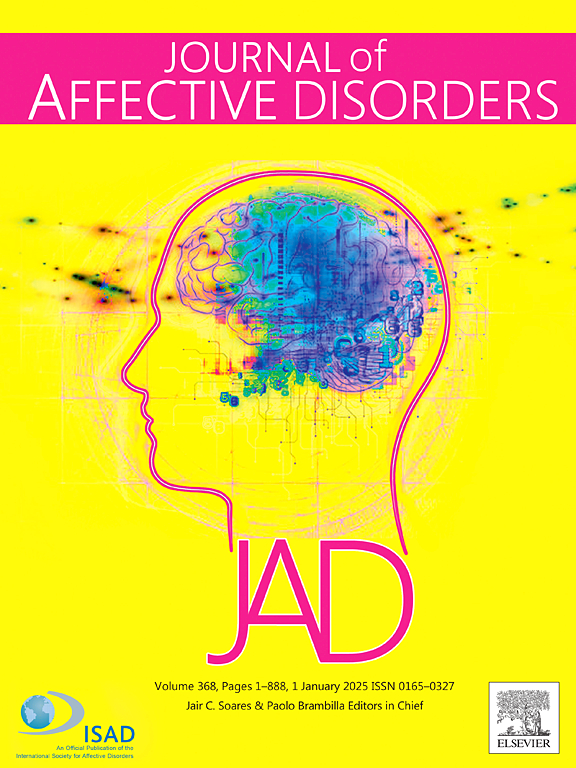Hemoglobin - to - red cell distribution width ratio in depression symptoms: Threshold effects and metabolic - inflammatory mediation revealed by multimodal machine learning and symptom network analysis in 196,260 adults
IF 4.9
2区 医学
Q1 CLINICAL NEUROLOGY
引用次数: 0
Abstract
Objective
To investigate the association between hemoglobin to red blood cell distribution width ratio (HRR) and depression symptoms.
Methods
This study enrolled 196,260 participants from Nanjing Gaochun People's Hospital between 2020 and 2024, using latent class analysis (LCA) to classify depression symptoms patterns, employing six machine learning (ML) algorithms to evaluate HRR's predictive value, and implementing symptom network (SN) analysis to explore the pathways of HRR's mechanism of action.
Results
Following the integration of key metabolic indicators including body mass index (BMI) and dyslipidemia, the gradient boosting decision tree model demonstrated the optimal predictive performance (The accuracy of the internal validation reached 0.6988, with a sensitivity of 0.8952, a specificity of 0.6824, an F1 score of 0.7540, and an AUC of 0.824. The accuracy of the external validation reached 0.6702, with a sensitivity of 0.6060, a specificity of 0.8743, an F1 score of 0.6054, and an AUC of 0.747), achieving a contribution score of 0.7 under HHR ≤ 8 conditions. In the metabolic-inflammatory pathway analysis, BMI exhibited significant bridge strength (1.08285495) while dyslipidemia showed prominent mediation centrality, indicating their critical mediating roles in the biological pathway.
Conclusions
HRR was significantly correlated with the risk of depression symptoms, suggesting that it may have the value of serving as a potential predictive biomarker. BMI and dyslipidemia played a role in the depression-inflammation/metabolic pathway, indicating the possibility of them being potential intervention targets.
抑郁症症状中的血红蛋白与红细胞分布宽度比:通过多模态机器学习和症状网络分析揭示的阈值效应和代谢炎症介导,共196,260名成年人。
目的:探讨血红蛋白与红细胞分布宽度比(HRR)与抑郁症状的关系。方法:本研究于2020 - 2024年在南京市高淳人民医院招募了196260名参与者,采用潜类分析(LCA)对抑郁症症状模式进行分类,采用6种机器学习(ML)算法评估HRR的预测价值,并采用症状网络(SN)分析探索HRR的作用机制途径。结果:在整合身体质量指数(BMI)、血脂异常等关键代谢指标后,梯度增强决策树模型的预测效果最佳(内部验证准确率达到0.6988,灵敏度为0.8952,特异性为0.6824,F1评分为0.7540,AUC为0.824)。外部验证的准确性为0.6702,灵敏度为0.6060,特异性为0.8743,F1评分为0.6054,AUC为0.747,在HHR≤8的条件下,贡献评分为0.7。在代谢-炎症通路分析中,BMI表现出显著的桥强度(1.08285495),而血脂异常表现出突出的中介中心性,表明它们在生物通路中具有重要的中介作用。结论:HRR与抑郁症状风险显著相关,提示其可能具有作为潜在预测性生物标志物的价值。BMI和血脂异常在抑郁-炎症/代谢通路中发挥作用,表明它们可能是潜在的干预靶点。
本文章由计算机程序翻译,如有差异,请以英文原文为准。
求助全文
约1分钟内获得全文
求助全文
来源期刊

Journal of affective disorders
医学-精神病学
CiteScore
10.90
自引率
6.10%
发文量
1319
审稿时长
9.3 weeks
期刊介绍:
The Journal of Affective Disorders publishes papers concerned with affective disorders in the widest sense: depression, mania, mood spectrum, emotions and personality, anxiety and stress. It is interdisciplinary and aims to bring together different approaches for a diverse readership. Top quality papers will be accepted dealing with any aspect of affective disorders, including neuroimaging, cognitive neurosciences, genetics, molecular biology, experimental and clinical neurosciences, pharmacology, neuroimmunoendocrinology, intervention and treatment trials.
 求助内容:
求助内容: 应助结果提醒方式:
应助结果提醒方式:


